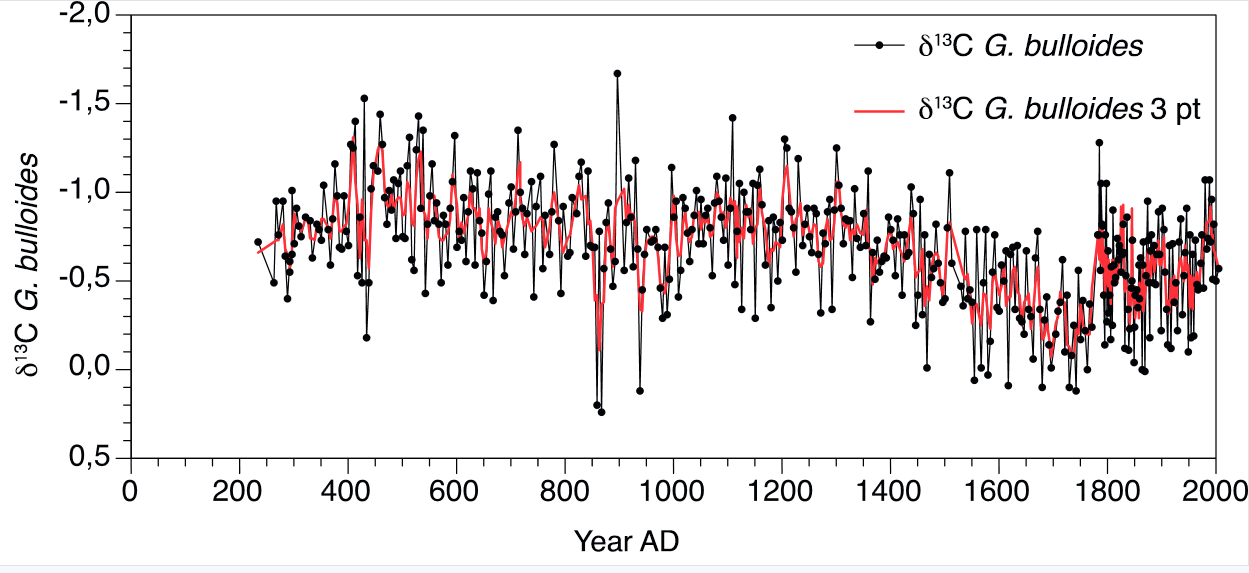The primary object of IMMUNITY is to integrate novel palaeoclimatic time series at unprecedented temporal resolution and instrumental data together with coupled atmosphere–ocean–sea-ice general circulation model simulations, in order to explore the long-term climate variations during the last 1500 years.
Analyses so far indicate that paleo reconstructions of ocean state variables generated by IMMUNITY deliver a temporal resolution that reflects the main decadal trends of instrumental data and thus can be used with confidence to develop a longer-term climate perspective (see figure). IMMUNITY has generated promising multiproxies for the reconstruction of key climatic features, such as deep overflows through the Iceland–Scotland ridge (Mjell et al., in prep) as well as frequency of storms and floods on land in Norway during the past millennia.
Major efforts have been devoted into a computationally efficient lower-resolution version of NorESM to make it suitable for millennial simulations and decadal prediction ensemble integrations. In this regard, the comparison of simulated and observed circulation of the North Atlantic gyre has given promising results.
Progress also has been made in elucidating the governing mechanisms behind multi-decadal climatevariability. The use of virtual drifters shows that, even in a coarse climate model, it is unusual for large volumes of warm surface water to be transported by the Gulf Stream into the Nordic Seas and Arctic (Medhaug and Czaja, in prep). Instead, observations and modelling agree that warm surface waters mostly recirculate in a loop and rarely reach high latitudes. In another investigation, the probability of having negative regional and global temperature trends for a control climate, historical observations and simulations, and for future scenarios using 17 models from CMIP5, has been analysed (Medhaug and Drange, in prep.). This analysis shows that the hiatus we have experienced the last decade or two is not uncommon even though we are experiencing a general warming of the global temperatures.
Potential mechanisms for decadal variability in the Pacific and East Asian summer monsoon have also been addressed during the past year. The role of anthropogenic forcing in shaping the weakened East Asian summer monsoon and associated anomalous precipitation in eastern China over the late 20th century (Wang et al., 2013) is highlighted. Finally, model output from the Bergen Climate Model and observations suggest that intensified solar radiation in combination with a lull in volcanic activity during the 1920s–1950s can explain much of the early 20th century Arctic warming (Suo et al., 2013).

__________
Medhaug, I. and Czaja, A. Surface exchange between the subpolar and subtropical North Atlantic using virtual drifters, in prep.
Medhaug, I. and Drange, H. Negative global and regional temperature trends in a warming climate, in prep.
Mjell, T. L., Langehaug, H. R., Otterå, O. H., Eldevik, T., Ninnemann, U. and Kleiven, H. F. Reconstructing
ocean circulation and climate based on the Gardar drift, in prep.
Suo, L., Otterå, O. H., Bentsen, M., Gao, Y. and Johannessen, O. M. (2013): External forcing of the early 20th century Arctic warming. Tellus A, 65, 20578.
Wang, T., Wang, H., Otterå, O. H., Gao, Y., Suo, L., Furevik, T. and Yu, L. (2013): Anthropogenic forcing of shift in precipitation in Eastern China in late 1970s. Atmos. Chem. Phys., 13, 12433-12450, doi:10.5194/acp-13-12433-2013.
